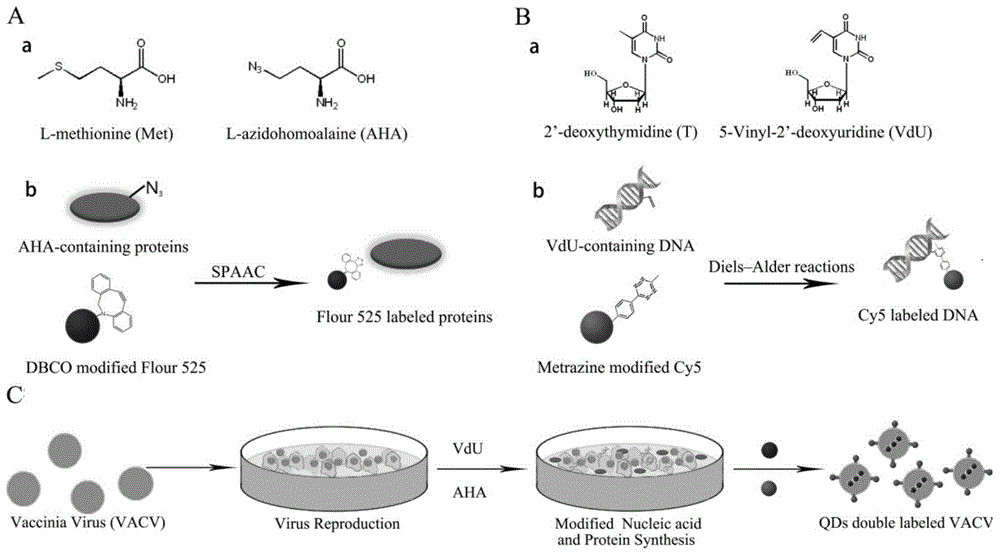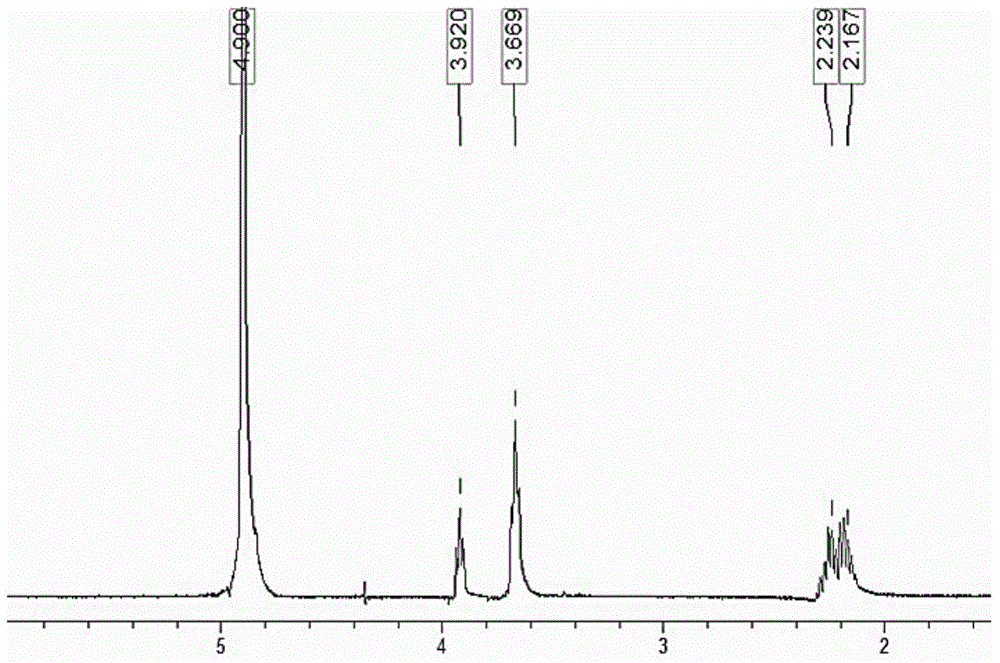Novel virus double-fluorescence labeling method based on nucleic acid and protein biosynthesis
A biosynthetic and fluorescent labeling technology, applied in the fields of chemistry and biomedicine, can solve the problems of inability to guarantee virus infectivity and virus activity, insufficient universality, cumbersome operation, etc., achieving small impact, good specificity, and easy operation. Effect
- Summary
- Abstract
- Description
- Claims
- Application Information
AI Technical Summary
Problems solved by technology
Method used
Image
Examples
Embodiment 1
[0025] A new method for dual fluorescent labeling of viruses based on nucleic acid and protein biosynthesis, the specific steps are as follows, as figure 1 Shown:
[0026] Step 1. Synthesizing methionine analogs --- azidohomoalanine (AHA) and deoxythymidine analogs --- ethylene deoxyuridine (5-Vinyl-2'-deoxyuridine, VdU);
[0027] The method of synthesizing azidomethionine is: dropwise to the NaN-containing 3 Distilled trifluoromethanesulfonic anhydride was added to the aqueous solution, and the reaction was stirred at room temperature for 2 h; the product was extracted twice with dichloromethane; at the same time, water and methanol were added to a round-bottomed flask equipped with a rotor, and then Boc-Dab (tert-butyl Oxycarbonyl-L-2,4-diaminobutyric acid), KCO 3 and catalyst CuSO 4 ·5H 2 O; add the extracted azide trifluoromethanesulfonic anhydride dropwise to the above reaction solution, and stir at room temperature overnight; rotate the reactant at 40°C to remove met...
Embodiment 2
[0043] A new method for dual fluorescent labeling of viruses based on nucleic acid and protein biosynthesis, the specific steps are as follows:
[0044] Step 1. Synthesizing methionine analogs --- azidohomoalanine (AHA) and deoxythymidine analogs --- ethylene deoxyuridine (5-Vinyl-2'-deoxyuridine, VdU);
[0045] Step 2, adding the virus into the culture medium containing the host cells for infection, and when the virus completely infects the host cells, that is, when the host cells become diseased, add azidomethionine and ethylene deoxyuridine to obtain cell A; Vinyl derivatization of viral nucleic acids and azido derivatization of proteins are achieved using the biosynthetic process of nucleic acids and proteins.
[0046] Step 3. Add fluorescent probe---tetrazine-Cy5 (Tetrazine-Cy5) to the cell A obtained in step 2, and obtain nucleic acid-labeled progeny virus by Diels-Alder reaction between tetrazine-alkene B; add a fluorescent probe --- cyclooctynylated Flour 525 (DBCO-Fl...
Embodiment 3
[0050] A new method for dual fluorescent labeling of viruses based on nucleic acid and protein biosynthesis, the specific steps are as follows:
[0051] Step 1. Synthesizing methionine analogs --- azidohomoalanine (AHA) and deoxythymidine analogs --- ethylene deoxyuridine (5-Vinyl-2'-deoxyuridine, VdU);
[0052] Step 2, adding the virus into the culture medium containing the host cells for infection, and when the virus completely infects the host cells, that is, when the host cells become diseased, add azidomethionine and ethylene deoxyuridine to obtain cell A; Vinyl derivatization of viral nucleic acids and azido derivatization of proteins are achieved using the biosynthetic process of nucleic acids and proteins.
[0053] Step 3. Add fluorescent probe---tetrazine-Cy5 (Tetrazine-Cy5) to the cell A obtained in step 2, and obtain nucleic acid-labeled progeny virus by Diels-Alder reaction between tetrazine-alkene B; add a fluorescent probe --- cyclooctynylated Flour 525 (DBCO-Fl...
PUM
 Login to View More
Login to View More Abstract
Description
Claims
Application Information
 Login to View More
Login to View More - R&D
- Intellectual Property
- Life Sciences
- Materials
- Tech Scout
- Unparalleled Data Quality
- Higher Quality Content
- 60% Fewer Hallucinations
Browse by: Latest US Patents, China's latest patents, Technical Efficacy Thesaurus, Application Domain, Technology Topic, Popular Technical Reports.
© 2025 PatSnap. All rights reserved.Legal|Privacy policy|Modern Slavery Act Transparency Statement|Sitemap|About US| Contact US: help@patsnap.com



